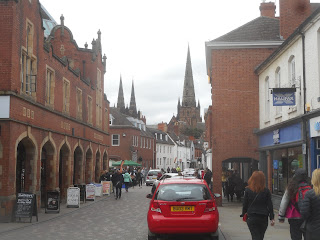Tuesday 19th March 2019
We
left Harvey on his own today and took the bus into Lichfiled. The bus passed
through South Fradley. Although classed as a village, this is in effect a small
town, built on the site of the RAF Lichfield airfield. Our 12-year-old guide
doesn’t even show it. The place is huge and is still being added to.
A
guy we spoke to went to school with the person who designed the place and has
known him ever since. He said he has always been a prat but until we went
through the village we didn’t really know what he meant. While the houses are
nice the roads twist and turn as a traffic calming measure and are so narrow
that two cars can barely pass each other and the bus had to swing right over
onto the wrong side of the road and kept mounting the kerbs. It seemed as
though the roads were designed for nothing bigger than an old Mini. It didn’t
make for a comfortable ride.
There
is a small arcade of shops with a Co-op, a gym, chippy and an Indian restaurant
but these were only built 2 years ago. No pub. Prior to that the only shop was
the small Post Office in Fradley.
The
bus then passed through Fradley Park Industrial Estate. This is massive, just
seemed to go on for ever with lots of warehouse distribution centres.
We
had been to Lichfield once before a number of years ago but didn’t have the
opportunity to explore the place. The city centre is only small but it has a
lot of history and a nice feel to it. Lichfield is known for its three spired
Medieval cathedral and the centre preserves its historic character with over
230 listed buildings.
The
birth place of Samuel Johnson and home of many famous people including Erasmus
Darwin, grandfather of Charles, David Carrick and Anna Seward, Lichfield was
described in the 18th century as “a city of Philosophers”.
We
took a roundabout route and came across St. Johns Hospital. This was founded in
1135 to accommodate pilgrims travelling to visit the relics of St. Chad which
were housed in the cathedral. Today the almshouses have been added to, to form
sheltered housing. The caretaker was good enough to allow us in to the chapel,
a tranquil place.
St Johns Hospital
After
walking around we came to the Cathedral Close and the Cathedral itself. A very
imposing building decorated externally with many statues. I had always wondered
why Lichfield became the ecclesiastical centre
of ancient Mercia when Tamworth was the seat of the King. St. Chad established his
Bishopric here in 669 AD, and the first Christian King of Mercia, Wulfhere,
then donated land for Chad to build a monastery.
The
cathedral is a magnificent, awe inspiring place. A guide, Gerald, spoke to us
at length when we entered and gave us a very interesting, brief history.
Although
on the site of earlier places of worship, building of the present cathedral was
begun in 1195. The walls of the Nave noticeably lean outwards due to the weight
of stone used in the ceiling vaulting, some 200-300 tons of which were removed
during renovation work to prevent the walls leaning further. The eastern end of
the cathedral is out of line with the rest of the building although it is not
known why. If you stand at the western end and line up the ceiling, the end
wanders off to the left.
There
were many artefacts including the “Lichfield Angel”, a stone sculpture that was
found in 2003 buried below steps in front of the altar. It is broken into three
pieces, believed to have been damaged by Vikings who sacked Lichfield in the 9th
century.
The
8th century St. Chad Gospels are on display. These bound manuscripts
contain the Gospels of Matthew and Mark and the early part of the Gospel of
Luke. They are believed to date from the year 730.
The
windows in the Lady Chapel contain some of the finest Medieval Flemish painted
glass in existence. Dating from the 1530’s, they came from Herkenrode Abbey in
Belgium.
Cathedral Interior
Lady Chapel Windows
Lichfield Angel
The wooden carved statues on the high altar
are particularly detailed as is the mosaic tiled floor.
The
South Transept houses memorials to the Staffordshire Regiment which includes a
Roll of Honour and many Regimental flags.
The
cathedral was extensively damaged during the English Civil Wars when the
central spire was demolished due to bombardment and all the stained glass
windows smashed.
After
leaving the cathedral we wandered around some more and had some lovely, naughty
but nice, chips done in dripping. We called into Debenhams for some clothes
shopping and then caught the bus back.
Lichfield
City Centre
We
took Harvey for a walk along the canal and for 100 yards or so along the
thundering A38 to the nearest pub, the Fradley Arms. An 18th century
coaching inn, it has been extensively renovated and is now a Premier Inn cum
Hungry Horse eatery. They wouldn’t let the dog in and so we had to sit outside
listening to the traffic, we had just the one pint and left.
Weather:
a nice pleasant day.









Comments
Post a Comment